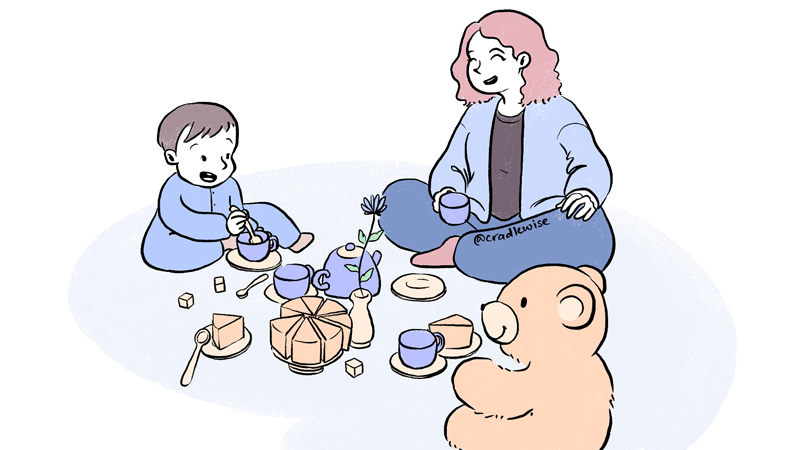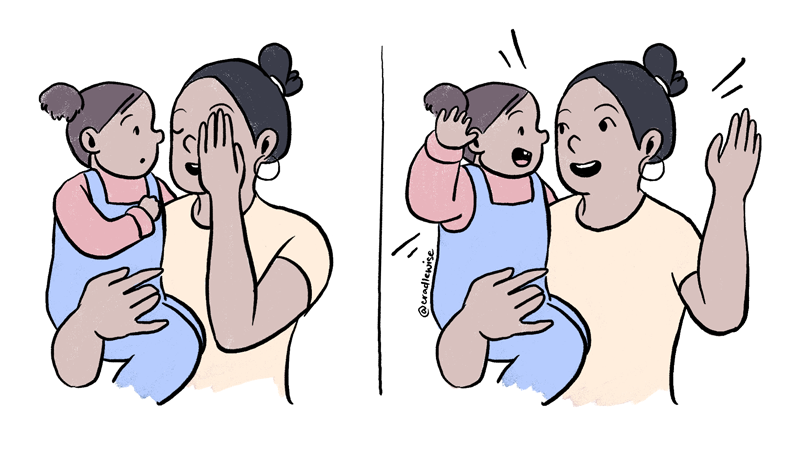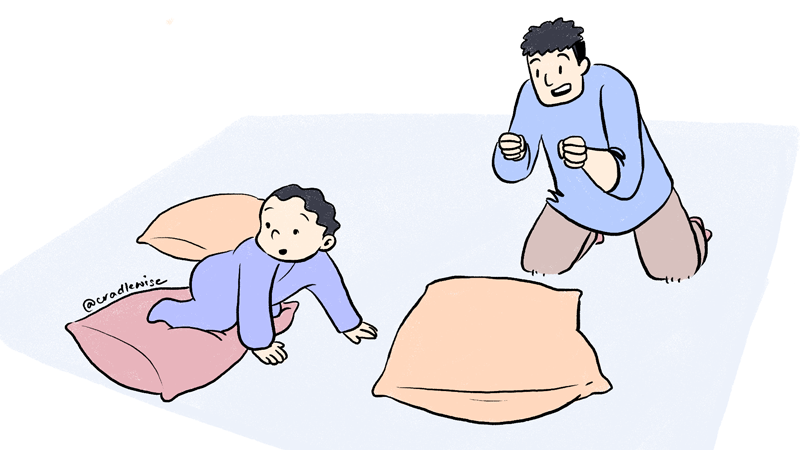Keeping little ones engaged and entertained can feel like a challenge, but winter takes the trickiness up a notch. Not only is winter colder, windier, rainier and snowier, depending on where you live, but the season tends to come with more sick days and snow days, which means more time cooped up at home. All the hours indoors can get monotonous, for parents and children alike.
But winter is also a great time to introduce new toys, games, and ways to play. Just as wintertime tends to require more effort for grownups to stay active and occupied, the same is true for children, points out Dan Rindler, baby movement expert, and Certified Feldenkrais and Somatic Experiencing Practitioner. “New experiences form new connections in the brain,” he says. “Overcoming new challenges (such as figuring out a new toy) leads to an increased sense of agency: your baby’s sense of being able to have an influence on their world.”
It’s easy to feel stir-crazy when options for outdoor time feel limited. Not to worry—there are plenty of ways to keep toddlers and infants entertained this winter. Check out our list of fun indoor activities for toddlers and babies that’ll occupy your little one for hours.
Sensory play
Sensory play is any type of activity that engages one or more of your baby’s five senses: taste, touch, smell, sight, and sound. Sensory play is critical to your child’s development, as it fosters curiosity, problem-solving, creativity, and even helps encourage language and motor skills, notes Nicole M. Avena, Ph.D., Assistant Professor of Neuroscience at Mount Sinai School of Medicine and author of What to Eat When You Want to Get Pregnant.
Create a sensory bin: For younger infants, Dr. Avena recommends putting different textured blankets and towels down on the floor to play with, touch, and crawl on. “After your baby reaches 6 months, you could even put different textured items in a box and have them pull them out one by one,” she suggests.
Arts and crafts
Arts and crafts foster creativity and hone in on fine motor skills—and holding crayons and brushes is great practice for tiny hands!
Finger paint: Finger painting is a great activity for babies 6 months and older. All you need is a set of finger paints and a large piece of paper. Warning: This will get messy—so be sure to set up on a surface you can easily clean, like the kitchen table or a newspaper-covered floor.
Music and Movement

There’s no better way to beat the winter blahs than to turn on the music and dance! Music has been shown to boost mood and reduce stress, increasing dopamine while reducing cortisol (the stress hormone) — and it can do the very same for babies. For toddlers and older babies on the move, finding ways to let them explore, climb, and cruise safely is a perfect winter afternoon activity.
Have a baby dance party: Turn on some music and dance with them, either in your arms or while they are lying down and having fun on a play mat.
Get a Pikler triangle. “A folding Pikler triangle, which looks essentially like a baby-sized ladder, is a great investment in your baby’s development and will be used for several years,” says Rindler. “The rungs of the triangle are great for pulling up to stand, or to cruise sideways.” The triangles also fold up neatly after playtime for storage.
Reading and Storytelling
Reading has developmental benefits at every age. In fact, reading to babies even as young as two weeks can foster communication skills while introducing colors, shapes, letters, and images.
Tell stories: Even if you’re not reading an actual book to your child, you can focus on storytelling from a young age simply by narrating the world to them. “Hold them by a window and describe each tree, animal, or bird you see,” suggests Dr. Avena. “Is it sunny out? Raining? Just describe the scenery. It can be a great way to practice mindfulness and keep your baby entertained.”
Building and Construction
Building and construction projects might seem advanced for a baby, but using blocks to create a castle or a house encourages your child’s fine and gross motor skills while enhancing creativity.
Magna-Tiles: This versatile toy lets your child build countless creations with varying-shaped tiles that cling together magnetically, from castles and rockets to school buses and animals.
Imaginative Play

You probably remember imaginative play as a huge part of your own childhood. Little did you know: While you were pretending to slay dragons and fly rocket ships, you were also building self-confidence, bolstering language and social skills, and encouraging creativity!
Have a tea party: If you have a pretend tea set or even some break-resistant kitchenware, you can have an imaginary tea party with your toddler. Create invitations and line up stuffed animals and dolls to add to the fun.
Games and Puzzles
Puzzles and games can help children and adults alike enhance their memories and even bolster IQ scores, notes Dylan Hes, M.D., pediatrician and medical director of Gramercy Pediatrics.
Play a matching game: Matching games are some of the oldest in the book and can be so stimulating for young children. You can purchase a matching game or even make your own. To go the DIY route, simply cut out small squares of paper and draw images on each one, making sure to have matching sets (i.e. two bananas, two hats, two cats or two houses). Then, flip each image over so that your child has to find the matching sets and pair them together.
Peek-a-Boo

Peek-a-boo is a time-honored game that helps bolster your baby’s senses, especially when it comes to visual tracking. It also almost always results in a gummy grin, which is a welcome reward for you!
Play peek-a-boo: You can play this game simply by hiding your face behind your hands for a few seconds before opening them up to reveal your face. Your baby will likely coo in laughter or offer you a big smile.
Felt board play
Versatile felt boards are M.V.P.s for long days indoors, since they encourage reinvention every time you play. You can use them to create works of art, tell a story, or even play a matching game.
Create a felt board scene: One of the simplest ways to use a felt board is to encourage your child to create a scene — whether it’s animals on a farm or friends having a picnic. Once the creation is complete, simply remove all the pieces and start again!
Blanket forts and pillow games

Building takes time, which can be on your side when you have an entire day to spend indoors. Working with your toddler to make a cozy fort from blankets and pillows helps encourage your child’s creativity and fosters imaginative play.
Build an obstacle course: For crawling-age babies and up, Rindler recommends building a homemade obstacle course. Simply throw all the couch cushions and pillows on the living room floor and let your child maneuver their way around. “You don’t need one of the couches specially made for this — any sofa whose cushions you’re willing to throw down will work, and provides great challenges for babies who are crawlers or beyond,” he says.
Create a tunnel: “A collapsible tunnel or a whole system of them (think baby-size hamster habitrail tubes) is great for crawling babies, or for babies who skipped crawling and went straight to walking,” says Rindler. “The tunnel takes some real courage to crawl through at first, but once your baby has tested the waters, they’ll have a great time circling in and out and playing peek-a-boo by hiding in the tunnel!”
Bubble wrap or balloons
Before you toss out the bubble wrap that came with your latest online shopping haul, consider keeping it for indoor play. Bubble wrap helps encourage fine and gross motor skills. It also helps foster hand-eye coordination, as your child learns to apply pressure to make the bubbles go “pop!” Remember to always supervise your children, especially when they’re playing with any kind of object that they could put in their mouth or cover their faces with.
Paint with bubble wrap: Bubble wrap creates fun textures on paper when covered with paint. Cut the bubble wrap into small pieces and encourage your child to paint each with a different color. Then let your child press the painted bubble wrap on paper to create interesting textures and effects.
Cardboard box towers
A simple cardboard box can serve as a wonderful developmental game. It’s a great way to foster imaginative play and serve as a safe place for your child to do other types of play, whether it’s reading a book or having a tea party.
Build a spaceship: If you have a large enough cardboard box (maybe the box the diapers came in), let your child decorate the outside like a spaceship and hop right in for a ride to space. Rindler suggests putting a few books inside to weigh it down, or a toy on top for a younger baby to reach for. “Older babies can practice crawling on top or even pulling up to stand at the box,” he says. “It’s very versatile too! In a moment’s notice it can become a drum or a ‘walker’ to push around the room.”
Learn more about managing your baby’s sleep schedule this fall, before the winter comes.
More posts you might like:




